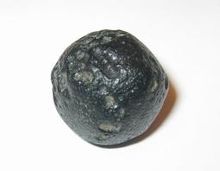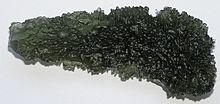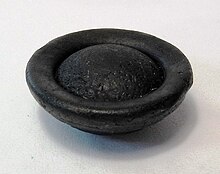Tektite
Tektite (from the Greek tektos melted) are to large to several centimeters glass objects which are indeed terrestrial origin, their formation but by the impact of large meteorites on the Earth's surface caused.
The impact melted earthly material and hurled it up to a few hundred kilometers, solidifying it to glass. Although caused by a meteorite impact, the tektites themselves are of earthly and not, as is often claimed, of extraterrestrial origin. In terms of color, tektites are black or greenish transparent. The shape varies from aerodynamically round, disc, teardrop or dumbbell to irregular.
Because of their origin, the sites of tektites are associated with impact craters . The tektites found in the Czech Republic , called moldavites , are associated with the Nördlinger Ries . So far, only four stray fields are known worldwide .
Types of tektites
Some types of tektites, grouped according to the four known different stray fields:
- European stray field
- Nördlinger Ries, Germany, an approximately 14.6 million year old impact crater that was formed during the Ries event .
- Moldavite (Czech Republic, greenish)
- Australasian stray field
- This largest stray field covers around 10% of the earth's surface. According to a research report published in late 2019, the crater is believed to be in the Bolaven Plateau in Laos and was covered by volcanic basalt deposits. The age of the tektites was determined to be around 790,000 years.
- Australite (Australia, dark, mostly black)
- Indochinite (Southeast Asia, dark, mostly black)
- Chinite (China, black)
- Port Campbell stray field
- Within the Indo-Australian stray field can be found in the region Port Campbell (South Western Victoria ) a smaller stray field that an age of about 10,000 years bp has thus in a recent impact has emerged.
- Campbellite (Australia Port Campbell, dark, mostly black)
- North American stray field
-
Chesapeake Bay Crater , USA ( Virginia , Maryland ), age: approx. 35 million years. Although the Bediasites have been known for several decades, the associated crater was not recognized as such until after 1990, as it is largely under sea and completely covered by sediments .
- Bediasite (USA, Texas, black)
- Georgiaite (USA, Georgia, greenish)
- Ivory Coast
-
Bosumtwi Crater, Ghana, age: around one million years
- Ivorite (Ivory Coast, black)
Like obsidian , tektites were also used thousands of years ago for everyday objects, as jewelry and for cultic purposes. So-called impact glasses are also produced by meteorite impacts . Unlike tektites, they are not thrown away, but remain in the vicinity of the crater.
See also
literature
- Henry Faul: Tektites are terrestrial. Science , Vol. 152, pp. 1341-1345, 1966.
- Guy Heinen: Tektite - Witnesses of Cosmic Disasters , self-published, Luxembourg, 1997. Online version
- Johannes Baier: On the origin and importance of the Ries ejection products for the impact mechanism. In: Annual reports and communications from the Upper Rhine Geological Association. 91, 2009, pp. 9-29, doi : 10.1127 / jmogv / 91/2009/9 .
Web links
Individual evidence
- Jump up ↑ Kerry See, Jason Herrin, Brian Jicha et al. : Australasian impact crater buried under the Bolaven volcanic field, Southern Laos. In: PNAS . 2019, doi : 10.1073 / pnas.1904368116 ( PDF; 3.8 MB ).
- ↑ Gill, Edmund Dwen (ED) 1970


